Tiny Epic Dungeons - A Solo Review
14 Jun 2022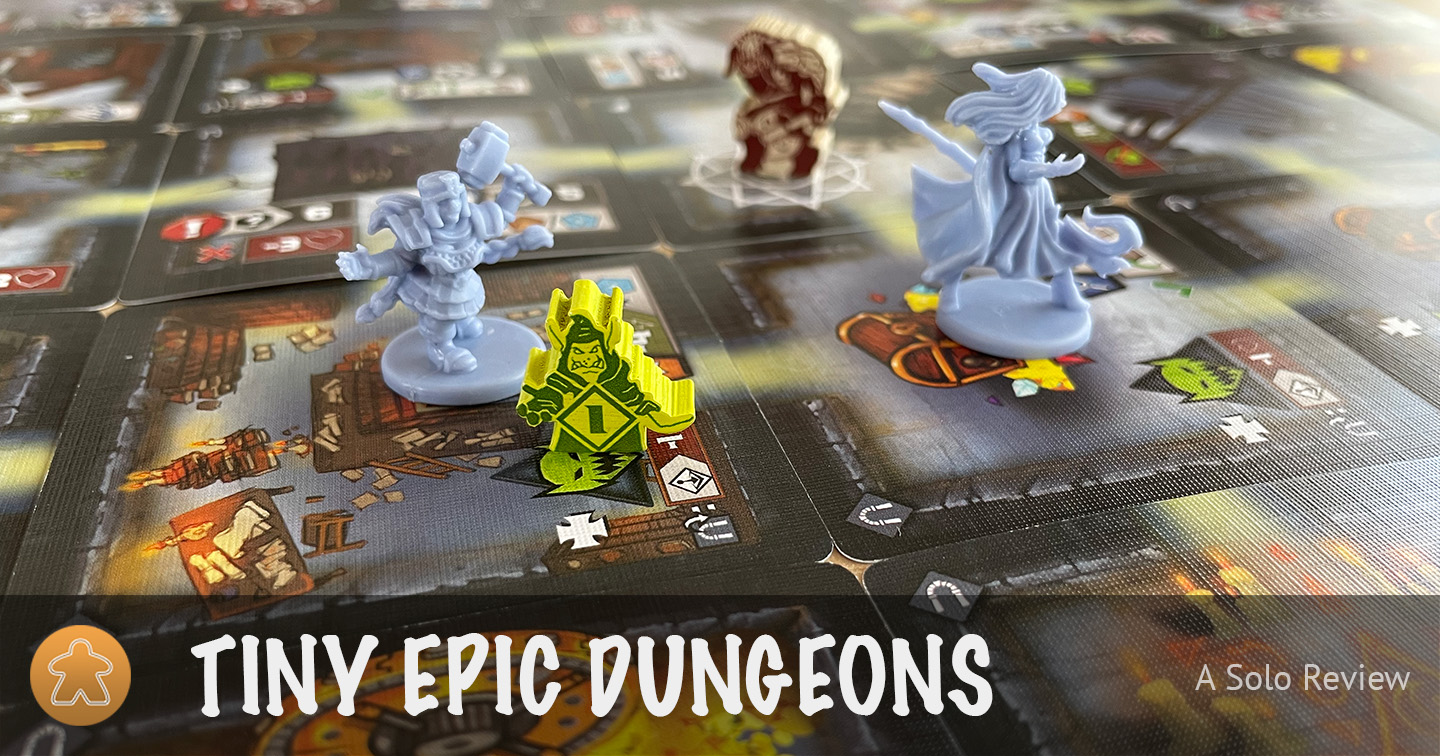
Just as you want to take a first sip of your ale, a man stumbles into the inn, panic in his eyes. “The g-g-goblins,” he stutters, “they’re c-c-coming closer!”. Not really a surprise, this region is called The Goblin’s Coast after all, but you have to agree the creatures have been coming closer to the village than ever before. You sigh, push back your ale and grab your axe. “Enough of this… I’ll go settle it once and for all,” you say while tossing a coin to the barkeep. As the doors close behind you, you hear someone mumble “Isn’t that what the last one said as well?”
Name: Tiny Epic Dungeons
Designer: Scott Almes
Publisher: Gamelyn Games
Game type: dungeon crawler
What is Tiny Epic Dungeons?
Tiny Epic Dungeons is a cooperative dungeon crawler for one to four players where each player controls a hero (or multiple heroes in case of a solo game) while exploring and navigating through a randomly generated dungeon, trying to find and defeat the dungeon boss.
Along the way you encounter goblins, strong minions and traps. Dealing with these requires rolling dice to make skill checks and can potentially reward you with items and spells.
You’ll need to balance taking your time equipping your heroes with powerful items and spells, with searching for and defeating the boss. Each turn your torch grows a bit dimmer and if it extinguishes completely you are stuck in total darkness and lose immediately.
How does it play?
As in many cooperative games, a solo game of Tiny Epic Dungeons is basically the same as the regular game, but instead you control all the heroes yourself. This means that you could play the game on your own controlling two, three or four heroes. Since the game scales to the number of heroes, it is perfectly fine to just stick to two heroes; if only to limit the mental overhead.
Setting up the game is pretty simple. Apart from shuffling some decks and setting aside some tokens, there are five things you need to do:
- Choose the two heroes you’re going to play. The game comes with eight different heroes, each with their own player board and miniature. The player board, which is a big (88 × 125 mm) card, contains the hero’s stats, special ability and tracks for health and focus, which is used to take certain actions.
- Choose a boss you are going to fight against. You can pick one at random or manually select one based on the difficulty level you want.
- Prepare the dungeon deck. The dungeon you are going to traverse is different every time you play the game. For a solo game with two heroes, you will create a dungeon deck of 21 cards. The first nine cards only have regular dungeon rooms, which can contain traps or goblins. The next eight cards contain six more regular dungeon cards and two minion cards. The final four cards contains the door to the boss’ lair.
- Take the torch track card and place the torch token on the space corresponding to the number of heroes you are playing. At the end of every hero’s turn, the torch token moves down one space. If it reaches the bottom, you lose.
- Take the dungeon entrance card, place it somewhere on the table and put your heroes’ miniatures on it. Next you take four cards from the dungeon deck and place one face down on each side of the dungeon entrance card.
When all that’s done, you are ready to play, taking turns with the heroes you control.

On a hero’s turn they can basically do three different things: move, take as much free actions as they can and want, and perform exactly one heroic action. We’ll go over the these options in a bit, but I first want to explain the skill checks and dice, since they are relevant for moving and most of the actions.
The game features three different skills: strength, agility and intellect. Each hero has a score from 1 to 3 for each skill. For example, Ethairna, the Elf Sorceress has 1 strength, 2 agility and 3 intellect while Sir Lanon, the Human Paladin, has 3 strength, 1 agility and 2 intellect. This score determines how many dice you get to roll when doing a check against that skill. Let’s say Sir Lanon has to do a strength check of at least 7 to evade a trap. His strength skill is at 3, so he gets to roll three dice. The dice are six sided and contain the values from 1 to 6, with the 1’s and 2’s having a plus sign in front of them: +1 and +2. After your roll, you need to select exactly one die you want to use for the skill check. If there are +1’s or +2’s among the other dice, you get to add them to the result of the die you picked. So if you roll a +2, a 5 and a 6, and you need pass the skill check of 7, you can pick the 5 or the 6 and add the +2 to get to a total value of 7 or 8. Some dice values also show health or focus symbols. For every die you don’t pick, you get to take the bonus indicated by the symbols on the die. So in the above example you could take the 5 and the +2 and leave out the 6 because that one shows a health symbol, allowing you to gain one health. I think this is a really clever and fun mechanic.
Now that you have an idea of how the skills checks work, let’s have a look at the different things you can do on a hero’s turn.
Moving
You hero mat indicates what your movement range is. This basically tells you how many movement actions that hero can take on their turn. Moving from one room to an adjacent room takes one movement action. When a hero moves into a room that’s still face down, you flip the card face up. You can orient it however you want, as long as the exit of the room the hero came from is connected to an entrance of the room they moved into. The maximum size of the dungeon is a 7×7 grid, so that’s something to take into account when orienting rooms.
Some rooms have a goblin or a minion symbol on them. This means that a goblin or a minion spawns there when the card is flipped over. If that happened because you moved into the room —there are other ways to flip rooms as well— you take some damage because you were foolish enough to let yourself be surprised. This also ends your movement; you are not allowed to move any further this turn.
Other rooms contain a trap. Every time you enter them, so not just when they are flipped over, you need to do a skill check to evade the trap. Failing the skill check typically means you take some damage, but there are also traps that spawn a goblin, so be careful!
Taking a heroic action
During your turn you can take exactly one heroic action. These heroic actions are indicated by a blue plaque and can be found on your hero mats, on dungeon tiles and on items and spell cards. All hero actions require you to do a skill check, except for the rest action, which gives you +3 health and +5 focus. Taking a heroic actions also ends your movement.
The most important heroic actions are searching a room (to get items/spells), casting a spell (e.g. to heal), disarming a trap and attacking.
In order to attack, you select one of your weapons. Either a default weapon printed on your hero mat or on of the item cards you have equipped. The weapon determines the skill check you have to make and up to which range you can attack. The dice result you get after your roll determines how much damage you do. This can be increased by certain modifiers from equipment and gets lowered by the defense value of the enemy you’re attacking. Whatever is left is the amount of damage you do. When you attack you also to roll the red enemy die. This determines the counter attack of the enemy, in case it survived your attack.
When you defeat a goblin you get the reward printed on the card of the goblin you defeated. This can be an item or spell you draw from the corresponding decks, or extra health or focus. When you defeat a minion, you get to draw two items, two spells or one of each and you get to move the torch six spaces back, buying you some more time!
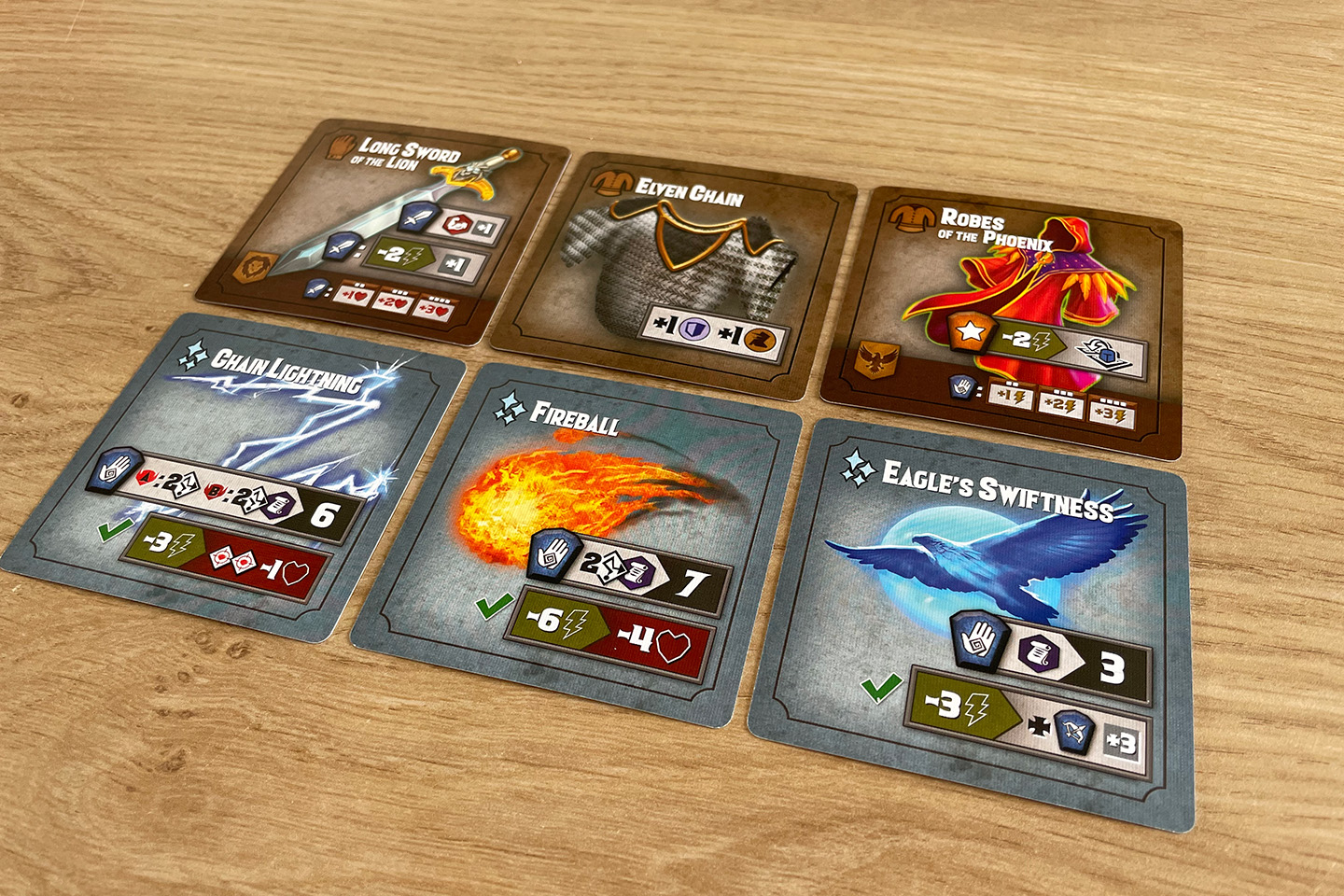
Disarming a trap is something you can do when you’re in a dungeon room that contains a trap. Regardless of whether you passed or failed the skill check to evade the trap, you can afterwards attempt to disarm it. When you succeed this skill check you get to place a token on the room and from then on, the heroes don’t need to do the evasion skill check anymore when entering the room. Disarming a trap also gives you extra things like items or spells!
Taking free actions
Free actions are indicated by an orange plaque and can be found in different places: on the torch track, on your hero mats, on dungeon rooms, … You can take as many as you can and want during you turn.
Free actions don’t require you to do a skill check. Instead you have to pay focus to use them.
The most important free action is probably spending two focus to increase or decrease the result of a die by one. So this way you can turn a 3 into a +2, or a 5 into a 6.
Back to the game!
Now that we’re familiar with the main concepts of the game I can explain how everything ties together and how a typical game of Tiny Epic Dungeon goes.
As I have explained you start the game with one dungeon room revealed: the entrance. You move from room to room, dealing with traps, goblins and minions while collecting items and spells, and hoping to find the room containing the door to the boss’ lair.
When you flip over a card that spawns a goblin, you take one of the four available goblin meeples (they come in four colors and are numbered 1 to 4) and place it on the room where it needs to spawn. You also draw a card from the goblin deck and place it on the placeholder on the torch track card that has the same color and number as the goblin meeple you just placed in the dungeon. This makes it easy to link a goblin meeple in the dungeon to a goblin card that shows the goblin’s stats and abilities. When you defeat the goblin, you move the goblin card to the discard pile and you move goblin meeple to its placeholder on the torch track card. If at any point you need to add a goblin while all four goblins are already in the dungeon, you immediately lose. So it’s important to not neglect the goblins for too long.
When you flip over a card that spawns a minion, you take a card from the minion deck and its corresponding minion meeple. Just like with goblins you place the meeple on the room where it needs to spawn. There are a few differences between goblins and meeples. For starters, the amount of minions you can encounter is limited since there are only as many minion spawning rooms as there are heroes. Another big difference is that goblins only have one health and are pretty weak, while minions have more health and it often takes more than two or turns to defeat them.
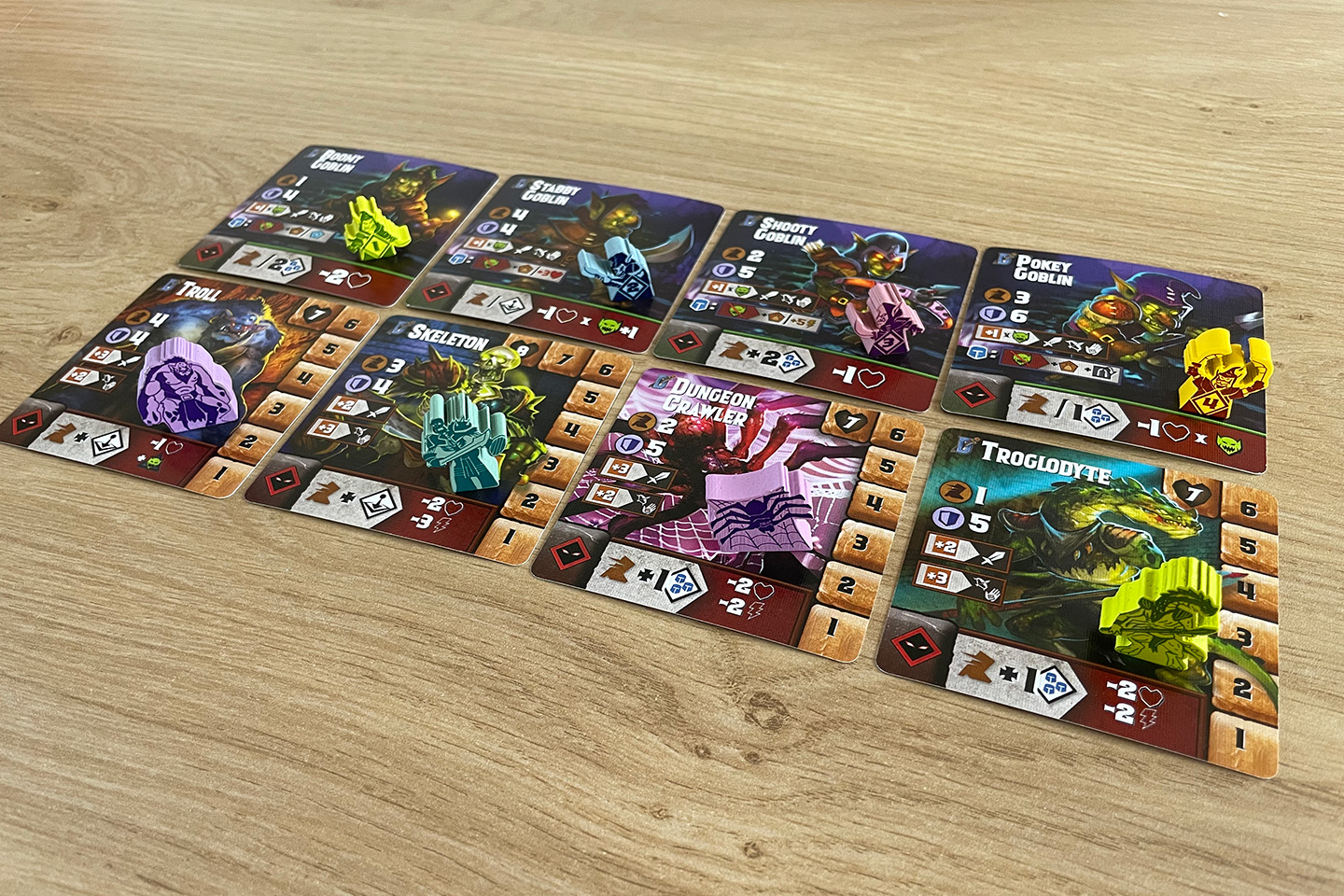
I have also mentioned that at the end of every hero’s turn the torch moves one space down on the torch track. Some of these spaces are empty and some have one of two possible icons on them. When the torch moves onto a space with an icon something happens. One type of icon makes a goblin spawn on the dungeon entrance. The other type activates all goblins and minions that are present in the dungeon. Every goblin and minion card indicates what happens when they activate. They both basically try to fight you. This means they either move closer to the closest hero, or they attack if a hero is in their range. Some even move and attack in the same activation.
When you have finally found the door to the boss’ lair, you can only enter it if you have managed to also find and defeat all minions. When you are ready to enter, you flip over the boss card and place one grey heart token (which you get for defeating minions) per hero at the right end of its health track. This shows you how much health the boss has left and it also means that the boss starts with more health if you play with more heroes. You also flip the torch card because it has a separate track for the boss phase. Every boss card has a few spaces at the bottom edge. These are movement spaces for you heroes. Each space has an effect that’s either positive (e.g. melee attacks get a +3 modifier on their roll when on that space) or negative (e.g. you lose 2 health when you end movement on that space).
If you think it’s just a matter of attacking the boss from now on, you are very wrong. Every boss has at least one icon somewhere on its health track. The grey hearts can only pass such an icon if it is covered by an altar token. You can find such a token on the dungeon entrance and on every room that spawned a minion. To transfer a token from the room to the boss card, you have to lure the boss to such a room. Keep in mind that the torch keeps moving down after every turn, limiting the time you get to do damage and move the boss around the dungeon.

Along the way your heroes will take damage, but luckily they can’t die. When their health track runs out they merely fall unconscious and their turn ends. When a hero starts their turn unconscious, they have to start by taking a rest action and can only move during that turn; they cannot take any free or heroic actions.
If —and this is a big if— you manage to defeat the boss before the torch reaches the end of the track, you win.
What does it look and feel like?
This is the fourth Tiny Epic game I’ve played and the level of quality seems to be pretty consistent. If you have experience with any of the Tiny Epic games, you will know what you can expect.
The cards feel very sturdy. Nice thick card stock with a finish that makes them feel they won’t wear down any time soon. The wooden components are all very well done and I love the screen printing on the goblins and the minions. The custom dice are the coolest part of the game for me. They are super pretty and are satisfying to roll. I’m also impressed by the fact that Gamelyn Games managed to fit eight distinct detailed miniatures in the box. It really adds to the game.

The graphical style of the art on the cards might not be for everyone, but personally, I like it. Very colorful and thematic.
All in all I really enjoy the visual and tactile experience of playing Tiny Epic Dungeons.
How much time does it take?
Setting the game up is fairly quick; I would say around five minutes. The same goes for packing everything up again.
How long it takes to play really depends on how quickly you manage to lose. If you have some bad luck with the layout of the dungeon, causing you to waste turns backtracking because you run into a lot of dead ends, or having your moving stopped a lot because of goblins, the torch track will probably run out before you manage to do anything substantially. I’ve managed to lose in about 15 to 20 minutes this way. On average though, I would say a game takes about 45 to 60 minutes.
What is my verdict?
There is a lot to like about this game. Exploring the dungeon, not knowing what you will discover in the next room, feels really exciting and thematic. The skill check mechanism, where you can only choose one die (and maybe add +1 and +2 dice) and get the bonuses of the dice you didn’t use is very clever and makes for some interesting choices. Being able to spend two focus to modify the result of a die by one gives you a way to mitigate the randomness of the rolls a bit and definitely comes in handy.
The torch track brings a feeling of urgency to the game which adds to the thematic tension. The downside is that this can make “wasted turns” feel frustrating from time to time. If you discover a goblin room on your first movement three turns in a row, you’ve only explored three rooms while the torch has moved about 25% down to the end of the track. If you want to beat the torch track you really need to keep the dungeon deck in mind and know when minion cards might come out. Orienting cards in a specific way when you’ve flipped them over can also help.
There are few things in the game I have issues with.
The first one is the randomness of the items and spells. If you want to have a chance to beat the boss, you will need to equip your heroes with decent equipment and spells. Unfortunately, the randomness when drawing items and spells feels like it has too big of a share in what makes or breaks your game. I have only won one of the eight games I’ve played so far, and it really felt like I won because I managed to get really good items and a single super powerful spell. If you already found a good melee weapons and you keep on drawing more melee weapons that you can’t really use, your characters will be underequipped to face the boss or even some of the minions. And because of the time pressure created by the torch track, you can’t really take your time searching for more items and spells. At a certain moment you will have try and take on the boss, well equipped or not.
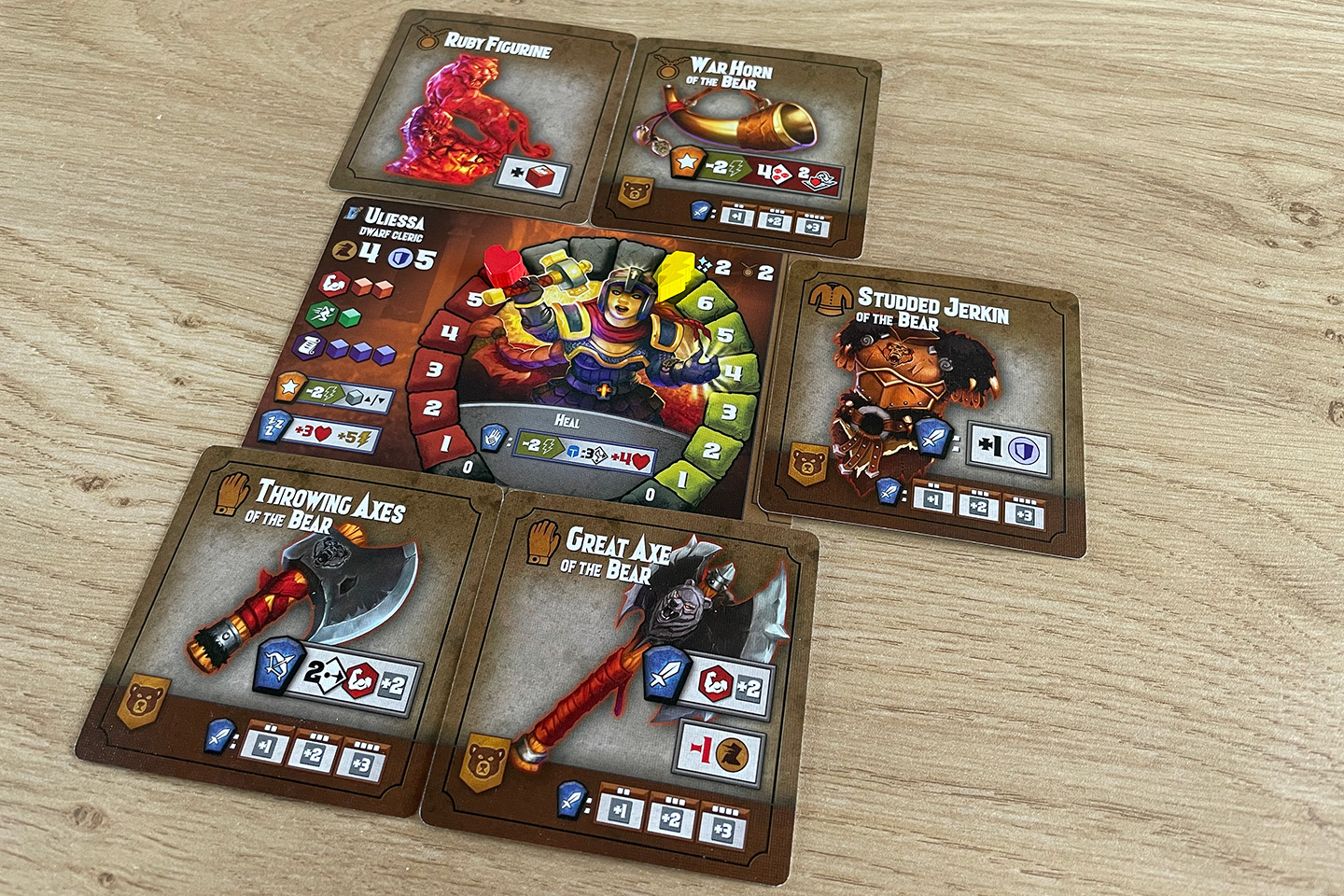
The second one is the heavy iconography. There are a lot of different icons and for some actions or spells these get chained into something resembling icon sentences. The problem is that these icons are not immediately intuitive. After eight games I am still looking things up in the rule book. The rule book contains a big overview of all the icons, but for some spells the icons are used in combinations and then the rule book is of no help. Gamelyn Games has linked a card appendix on their website, which explains every hero ability, item and spell in detail. You really need that appendix to be able to play the game.
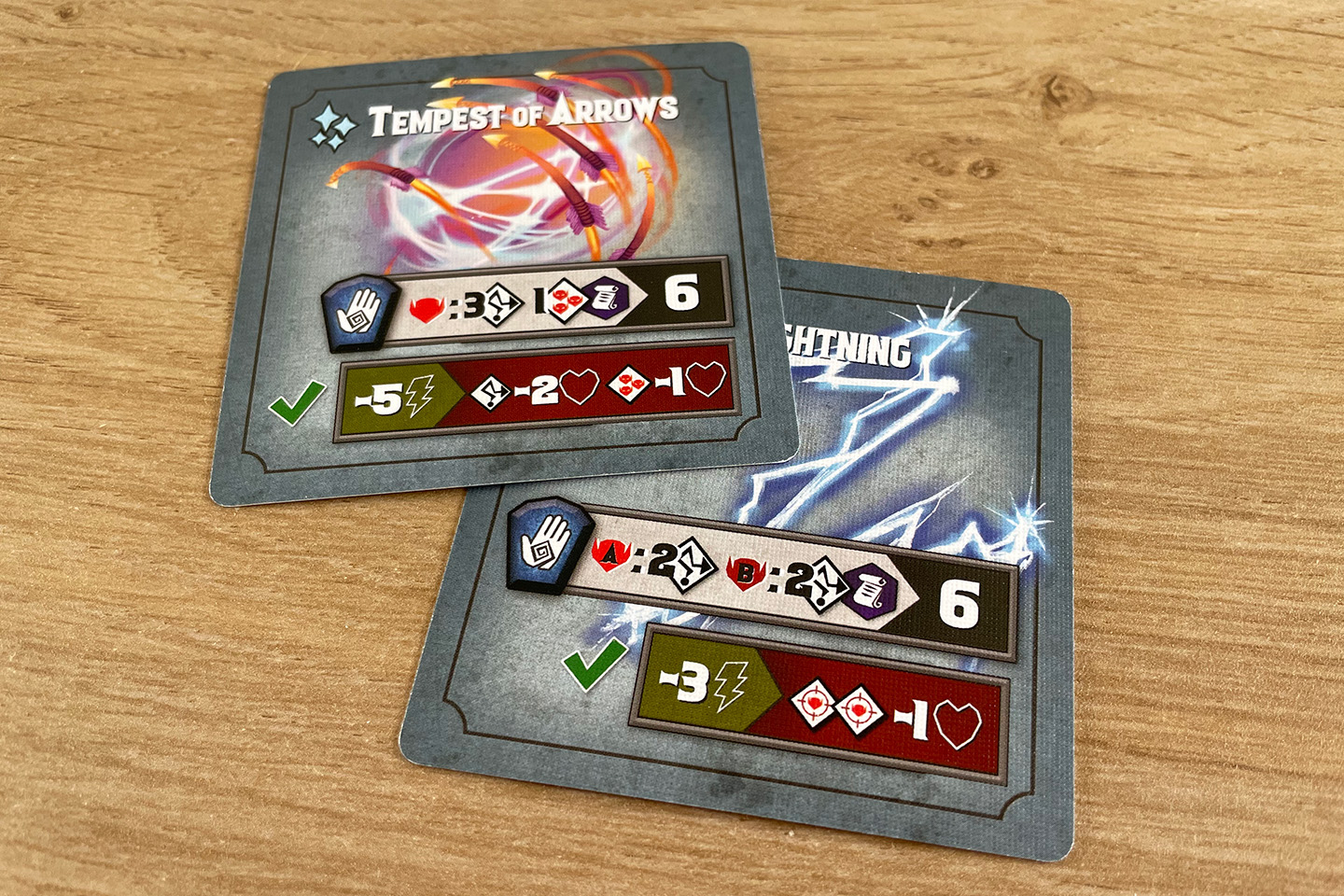
Even though the game feels really hard and punishing and too random when it comes to the items and spells, I do find myself coming back to it, because exploring the dungeon is just so much fun. Combined with the ability to play in an hour, including setup and teardown makes this a nice filler game for me. It’s not a game I’ll play every day or even every week, but I definitely see myself coming back to it for a long time.
Score
To make things easier for myself, I use the same scoring categories Board Game Geek uses.
Comments
I'm sorry, I don't support comments on my website. If you want to discuss the game or my review, feel free comment on this dedicated Instagram post or my review on BGG.